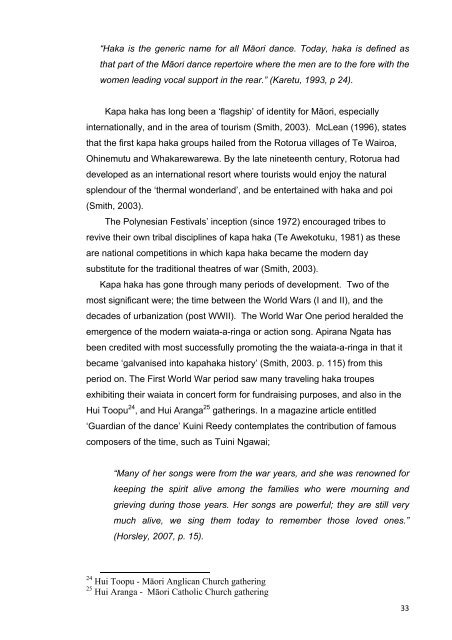Te Māoritanga WELLBEING AND IDENTITY Kapa Haka as a Vehicle
Te Māoritanga WELLBEING AND IDENTITY Kapa Haka as a Vehicle
Te Māoritanga WELLBEING AND IDENTITY Kapa Haka as a Vehicle
Create successful ePaper yourself
Turn your PDF publications into a flip-book with our unique Google optimized e-Paper software.
“<strong>Haka</strong> is the generic name for all Māori dance. Today, haka is defined <strong>as</strong><br />
that part of the Māori dance repertoire where the men are to the fore with the<br />
women leading vocal support in the rear.” (Karetu, 1993, p 24).<br />
<strong>Kapa</strong> haka h<strong>as</strong> long been a ‘flagship’ of identity for Māori, especially<br />
internationally, and in the area of tourism (Smith, 2003). McLean (1996), states<br />
that the first kapa haka groups hailed from the Rotorua villages of <strong>Te</strong> Wairoa,<br />
Ohinemutu and Whakarewarewa. By the late nineteenth century, Rotorua had<br />
developed <strong>as</strong> an international resort where tourists would enjoy the natural<br />
splendour of the ‘thermal wonderland’, and be entertained with haka and poi<br />
(Smith, 2003).<br />
The Polynesian Festivals’ inception (since 1972) encouraged tribes to<br />
revive their own tribal disciplines of kapa haka (<strong>Te</strong> Awekotuku, 1981) <strong>as</strong> these<br />
are national competitions in which kapa haka became the modern day<br />
substitute for the traditional theatres of war (Smith, 2003).<br />
<strong>Kapa</strong> haka h<strong>as</strong> gone through many periods of development. Two of the<br />
most significant were; the time between the World Wars (I and II), and the<br />
decades of urbanization (post WWII). The World War One period heralded the<br />
emergence of the modern waiata-a-ringa or action song. Apirana Ngata h<strong>as</strong><br />
been credited with most successfully promoting the the waiata-a-ringa in that it<br />
became ‘galvanised into kapahaka history’ (Smith, 2003. p. 115) from this<br />
period on. The First World War period saw many traveling haka troupes<br />
exhibiting their waiata in concert form for fundraising purposes, and also in the<br />
Hui Toopu 24 , and Hui Aranga 25 gatherings. In a magazine article entitled<br />
‘Guardian of the dance’ Kuini Reedy contemplates the contribution of famous<br />
composers of the time, such <strong>as</strong> Tuini Ngawai;<br />
“Many of her songs were from the war years, and she w<strong>as</strong> renowned for<br />
keeping the spirit alive among the families who were mourning and<br />
grieving during those years. Her songs are powerful; they are still very<br />
much alive, we sing them today to remember those loved ones.”<br />
(Horsley, 2007, p. 15).<br />
24 Hui Toopu - Māori Anglican Church gathering<br />
25 Hui Aranga - Māori Catholic Church gathering<br />
33
















